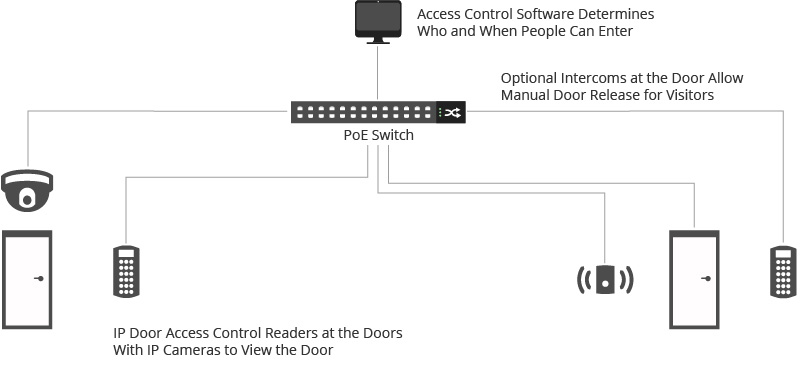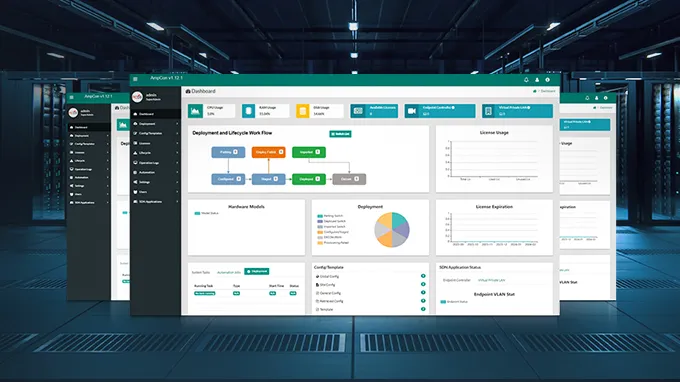Overview of PoE Access Control Systems
A door access control system is a vital component of contemporary security, providing an effective means to handle entrance points in residential or commercial facilities. PoE systems have grown in popularity in recent years, and they have been employed in various current Internet of Things (IoT) applications, including access control systems. The PoE Ethernet Door Controller is an ethernet power source device that permits network connection with entry points in the access control system. Using PoE access control systems can help access control devices transfer data for better control and a more streamlined system. In this post, you will learn the concept, advantages, potential drawbacks as well as the differences between traditional access control systems.
What is A PoE Access Control System?
A PoE access control system is a security system that combines both power and data transmission over a single Ethernet cable. It utilizes PoE technology to provide power to access control devices, such as door controllers, card readers, biometric scanners, and electric locks, through the same Ethernet cable used for data communication.
In a PoE access control system, the power is supplied from a PoE-enabled network switch or a PoE injector, eliminating the need for separate power cables and electrical outlets for the access control devices. This simplifies the installation process and reduces costs.

PoE Access Control System vs Traditional Network Access Control System
The traditional access control systems use the traditional RS485 (serial) network shown in the following left figure. Therefore, many of them are difficult to manage and hard to troubleshoot when the network goes down. In this infrastructure, the RS485 network is an independent network deployed to each controller in the access control system. The power supply for the controller is typically providing DC power and is provided with a battery backup. However, in a PoE access control system, single-door access control panels can be located above each door as edge controllers. These controllers make all access control decisions just like their analog predecessors. These single-door access control panels are powered either by a midspan PoE power injector or a PoE switch to provide reliable power.

Advantages of The PoE Access Control System
Compared to traditional electronic access control systems (ACS), a PoE access control system has three main advantages listed below:
-
Cost-saving: PoE access control systems provide significant infrastructure cost benefits. You do not need the junction box above the door, as well as the high-voltage power supply, network or building controllers, and local battery packs. This infrastructure leverages the existing IT network system, which helps to reduce the cost.
-
Flexible installation: The PoE cables transmit both power and data together to each device attached to the local area network (LAN). Normally, a device must be close to an AC power outlet for optimal performance. PoE expands the flexibility of device positioning, allowing devices to be installed easily in a network without the concerns of their proximity to AC outlets. What’s more, with a PoE access control system, there is no need to spend time installing AC outlets since a PoE switch can provide power for the devices, saving time and resources.
-
Easy and safe management: The power over Ethernet system uses a centralized power source, allowing remotely powered devices to connect and disconnect during service reconfigurations and disruptions easily. Besides, PoE technology helps protect the whole network investment because it has established an 802.3 Ethernet protocol extension and is supported by various data rates that reach up to 10 Gbps. The PoE access control system broadens the security initiatives of building premises by supporting CCTV devices for better surveillance. Digital signals allow the cameras to monitor who is accessing the premises.
The Potential Limitation of The PoE Access Control System
Although there are many advantages to a PoE ACS, there is one limitation as well. The only drawback of PoE systems is the limited power transmission to the connected equipment. PoE switches or PoE injectors not only power the controllers but also supply output power to ancillary devices such as card readers, fail-secure electric strikes, etc., which are connected to the controllers. Normally, there are two voltage limits for most PoE controllers. One is the lock output power, and the other is the total power output. In most cases, the total power output for all ancillary components, including the lock power, is approximately 600 mA. This requires that every component connected to a PoE controller be prescreened to determine the amperage draw so the total amperage for all components is less than the total output limits of the controller. Despite the limitation, a PoE access control system can still meet most application needs.
Conclusion
In conclusion, the PoE access control system is required to build the future of security. PoE adds scalability, manageability, and flexibility to the access control network, hence boosting the overall security infrastructure of any location.
You might be interested in
Email Address

-
PoE vs PoE+ vs PoE++ Switch: How to Choose?
May 30, 2024













